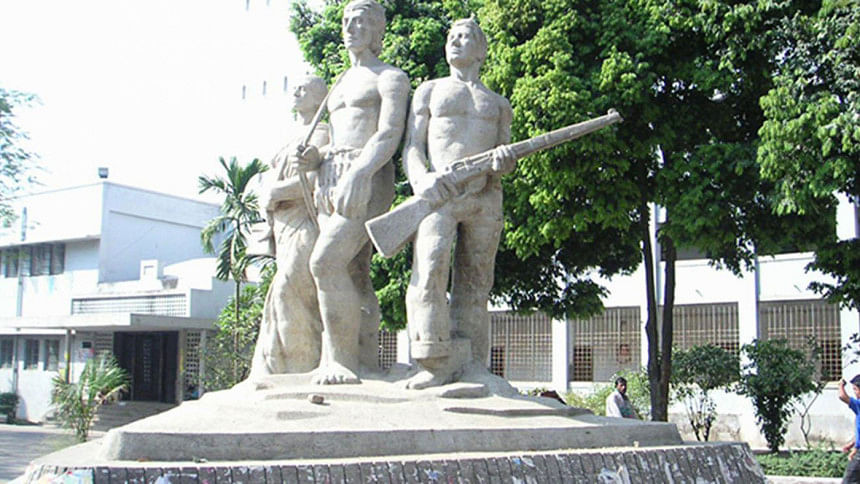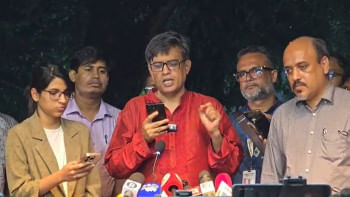A hitchhiker’s guide to our educational galaxy

Let's admit it: our education today is in crisis. And it was in crisis even before the pandemic was here. The pandemic has exposed the skeletons we have been hiding in the open for a long time. As we begin the centenary celebration of the oldest university in the country, Dhaka University, we need to reflect on the "splendid imperial concession" that had made the establishment of the university possible. The birth of Dhaka University is tinged with a colonial legacy. And the university came of age when students voiced a resounding "no" to the introduction of Urdu as the state language of Pakistan. That collective "no" became the voice of the nation and eventually paved the way for the country's political freedom. The middle-class students managed to excite the imagination of the masses to pursue their freedom; it is no coincidence that the centennial celebration coincides with that of the Father of the Nation who came to political prominence during his days in Dhaka University. It is the shining star of our educational galaxy.
Then again, Dhaka University epitomises the paradoxes of our education system: it airs the fresh breath of freedom, yet it has not been able to break away from the shackles of colonial pedagogy.
The university has failed to take leadership in the academic field, update its curricula keeping pace with the best practices of the world, and form a national consciousness on knowledge development highlighting the needs for indigenisation and decolonisation. The university has simply managed to promote a fallacy that you learn more simply by loitering in the corridors of the university and pursue success by queuing up for a seat in the library at the break of dawn to sit with your BCS guidebooks. The university results have become secondary to those in competitive exams. This is symptomatic of a weak system that has stopped instilling hope in its students. Students are left to their own devices where they learn (read, memorise) on their own to become civil servants. Then there are the other groups who try to expose them to the corporate culture and eventually become grasshoppers in the service sector. These business-minded students try to blend in a corporate ecology only for a while and sail away whenever the wind is right. We have two kinds of outputs: one group simply adds to the ring of a deeply rooted, ageing tree of bureaucracy, and the other drifts away like a dandelion with no roots of its own. If ends justify the means, surely there is something wrong with the means.
You must be thinking that with 150-plus universities in the block, why flog the old horse which is one hundred years old? It is because Dhaka University is the corpse of the century that contains "the ancient pulse of germ and breath… shrunken hard and dry" (The Darkling Thrush by Thomas Hardy), and we must resuscitate it not only to revive one institution but also our entire education system. Dhaka University must set the standard for others. In the absence of a local heritage, we are becoming mimic men, constantly looking for overseas benchmarks and success stories. More and more, institutions are pursuing the golden deer of world rankings and international markers. Unless our students are made proud of their heritage, they will be deceived by the corporate instruments of rankings that privilege cash investment above everything else.
I am not asking for any largescale rejection of western parameters. The two of the terms I broached earlier would help you understand my position. Indigenisation, for instance, "is a process of naturalising indigenous knowledge systems and making them evident to transform spaces, places, and hearts" (Antoine et al. Curriculum Developers). This process demands a blend of indigenous approaches and Western ones. Decolonisation, on the other hand, challenges and defies the privileged positioning of colonial ideologies and Western thoughts and approaches.
The supremacy of the west is best detected in Rudyard Kipling's "The Ballad of East and West". The opening line of the poem claims, "Oh, East is East, and West is West, and never the twain shall meet." Tagore in his essay "Creative Unity" responded to such a proposition by saying that West views the East as nothing more than a machine to run its empire. It misses to identify the human elements in us. Hence Tagore rephrased the line, saying, "Man is man, machine is machine, and never the twain shall wed."
Similarly, our educators too must remind ourselves of the human elements that form the basis of our indigenous pedagogy. Historically, we had a rich tradition of imparting knowledge that involved the gurukula (a mentor-mentee system). Then of course, from the 5th to the 12th centuries, the Buddhist monasteries had a serious impact on our education. Nalanda (in present-day Bihar) is a UNESCO heritage site that is dubbed the oldest university-system of education in the world. The architectural remains of Paharpur resembling Nalanda suggest that we too have the shared legacy of education. It was a time when education was considered to be a higher virtue practiced by the monks and the novices on the order of teaching. With the advent of Islam, madrassas and maktabs were established to teach grammar, philosophy, mathematics, and law influenced by the Greek traditions inherited by Persia and the Middle East. This traditional Islamic education emphasised the importance of a connection between science and humanities. When the British came in, they deemed new applications of local education. The East India Company wanted some educated Indians to assist them in the administration of the land. They needed some local educated agents who would help them understand the local customs and laws. The establishments of the Calcutta Madrassa by Warren Hastings in 1781 for the teaching of Muslim law and a Sanskrit College in Varanasi by Jonathan Duncan in 1791 for the study of Hindu philosophy and laws are cases in point.
Conversely, the missionaries facilitated the spread of Western education in India primarily for Christianising (which they deemed equivalent to "civilising") the natives. The British government was thus divided in their views on what kind of education was to be offered to the Indians. While the orientalists preferred Indians to be given traditional Indian education, the other groups wanted a western style of education with western subjects being taught to the locals. (Our three-track education system today continues to ring the same division bells).
In 1835, Lord William Bentinck's government decided that western sciences and literature would be imparted to Indians through the medium of English. Bentinck appointed Thomas Babington Macaulay, an ardent anglicist who had absolute contempt for Indian learning, as the Chairman of the General Committee of Public Instruction. Macaulay Minutes on Education 1835 became definitive for the education that we have inherited. In his proposal of education for the Indians, Macaulay considered the oriental culture to be "defective" and "unholy". He proposed English education in place of traditional Indian learning and offering of education to a few upper and middle-class students. His infiltration theory involved the idea that in the course of time, education would trickle down to the masses. He wanted to create "brown coconut" like sahibs who would be brown outside, but "white" inside. In short, Macaulayism is the policy of eliminating indigenous culture through a planned substitution with the alien culture of a colonising power via the education system.
In 1854, this changed slightly when there was an attempt to spread education by Sir Charles Wood, the President of the Board of Control of the company. Wood sent a dispatch to the then Governor-General of India, Lord Dalhousie. This "Wood's Dispatch" is often called the "Magna Carta of English education in India" as it recommended, among others, the reformation of education system from the primary to the university levels, education in both English and native languages, creation of educational institutes in all provinces, establishment of at least one government school in every district, aids for affiliated private schools, and offering education to women. The inceptions of Universities of Madras, Calcutta and Bombay were done by 1857. This dispatch asked the government to take up the responsibility of education of the people.
Dhaka University was established in 1921 as an imperial concession for the annulment of Partition of Bengal in 1911. Soon after the annulment, Bengali Muslim elites approached the Viceroy and explained how the partition of Bengal would affect the educational progress of the Muslim community. Viceroy Lord Hardinge was instrumental in the formation of the Nathan Commission which eventually recommended the establishment of a university in Dhaka. In its first convocation, Lord Lytton said, "this University is Dhaka's greatest possession, and will do more than anything else to increase and spread the fame of Dhaka beyond the limits of Bengal or even of India itself."
Lord Lytton is partly right. Indeed, the university is famed for its involvement in various national and cultural events related to our national consciousness. But somehow, if I may suborn, the university has failed to lead from the front, especially in recent years. My position in the totem pole does not allow me to point out the evil spirits that plague the system, but as a member of this institution I look forward to the day when this university is famed for its visionary leadership that engages with its colonial past, negotiates with the machine-making pedagogy of the present, and aims for a future that frees the mind from any forms of rigidity.
Shamsad Mortuza is a professor of English at the University of Dhaka (now on leave). Currently, he is Pro-Vice-Chancellor of ULAB. Email: [email protected]

 For all latest news, follow The Daily Star's Google News channel.
For all latest news, follow The Daily Star's Google News channel. 



Comments